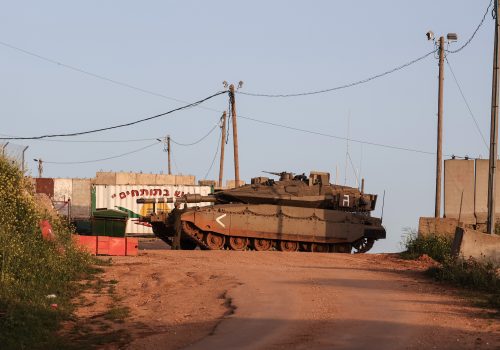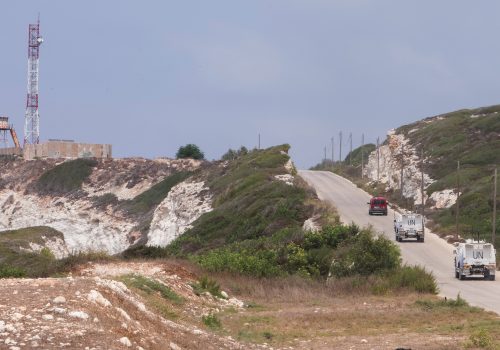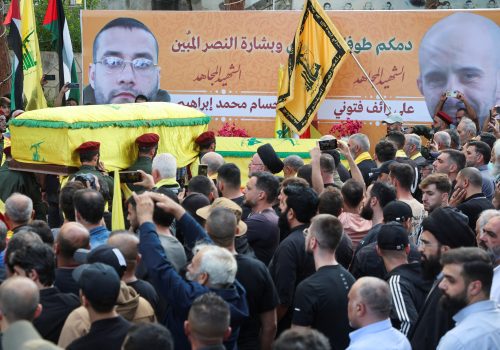A steady escalation along the Lebanon-Israel border—and no end in sight
Clashes along the Lebanon-Israel border have steadily escalated lately, even as international diplomats scramble to find a solution to return calm to the region. In recent days, Israel has attacked deeper into Lebanon with a series of airstrikes that have killed Hezbollah fighters, some of them senior officers, and several Lebanese civilians.
On February 19, Israel staged airstrikes against two warehouses in Ghaziyeh, just south of Sidon and some 50 kilometers (31 miles) north of the border. Israel claimed they were Hezbollah arms depots and that the strikes came in response to an apparent suicide drone that crashed and exploded earlier in the day near Tiberias, some 28 kilometers (17 miles) south of the border. If the drone was dispatched by Hezbollah from Lebanon, it would have been the deepest attack into Israel since the clashes began along the Lebanon-Israel border on October 8, 2023, a day after Hamas launched its devastating assault on Israeli communities and military bases adjacent to the Gaza Strip, killing some 1,200 Israelis. Lebanese media reports said that the targets in Ghaziyeh were a cement factory and an oil production plant.
On February 14, an Israeli soldier was killed and eight others wounded when rockets were fired from south Lebanon and struck Safed and the surrounding area. Safed is home to the headquarters of the Israeli military’s Northern Command and has been targeted before by Hezbollah. In response, Israeli jets carried out raids deeper than usual into south Lebanon, which left a mother and two children dead in the village of Sawwaneh, and killed at least five members of a family when their house was partially destroyed in the town of Nabatiyeh. The target had been Ali Deeb, a senior Hezbollah field commander, who died in the airstrike on the house. He had been wounded days earlier when an Israeli drone fired a missile at his car, also in Nabatiyeh. In the tit-for-tat manner of the fighting, Hezbollah fired Grad rockets into Kiryat Shmona on February 15, claiming the attack was a response to the deaths of civilians the previous day.
Around 268 Lebanese, most of them Hezbollah fighters, have been killed since fighting broke out more than four months ago. Ten soldiers and six civilians have been killed on the Israeli side. Tens of thousands of Lebanese and Israeli civilians have fled the fighting.
Hezbollah launched its campaign under the rubric of offering “support to the Palestinian people and the resistance in Gaza,” and said its actions are directly tied to the Gaza conflict.
“When the war on Gaza ends, we will stop our offensive,” Hezbollah Secretary General Hassan Nasrallah said on February 13. “If the enemy resumes its hostilities, we will act in light of the rules and formulas.”
Despite the intensifying violence of recent weeks, the fighting between Hezbollah and the Israeli military still falls well short of reaching a threshold that could precipitate war. Hezbollah’s actions clearly demonstrate that it and its patron, Iran, have no appetite for a full-scale war with Israel. In general, Hezbollah is in a reactive mode, escalating only in response to an increase in the tempo of Israeli attacks or when there are Lebanese civilian casualties.
For the most part, Hezbollah’s attacks—averaging around five or six a day, judging from Hezbollah’s daily statements—have become routine. Hezbollah’s targets are mainly Israeli border posts. Hezbollah primarily employs anti-tank weapons, most of them legacy systems, including 106-millimeter recoilless rifles and wire-guided AT-3 Sagger missiles, both of which date back to the 1960s. Even the more modern AT-14 Spriggan (known in Lebanon by its Russian name “Kornet”) is a second-generation version dating back to 2006. These line-of-sight systems require the operator to have a direct view of the target—for example, an Israeli outpost. Given that these anti-tank systems have a relatively short range, the Hezbollah attack squad must be within 5 kilometers (3 miles), the maximum range of the second-generation AT-14, of the target. Therefore, the conditions required to fire anti-tank missiles limit the number of locations from which attacks can be launched, making the Hezbollah units particularly vulnerable to Israeli drones prowling overhead in the skies of the south Lebanon border district.
Initially, Israeli drones attacked the missile units in the open. More recently, the drone locates a Hezbollah unit in the field and then tracks it back to a house. The house is subsequently targeted by a drone or jet. This appears to have been the fate of Hussein Yazbek, a local Hezbollah official, who was killed in the early hours of January 3 when an airstrike in the coastal village of Naqoura destroyed his home. The blast killed three additional Hezbollah men, all of them from different villages, suggesting that they may have been on an operation when they were spotted and tracked back to Yazbek’s home.
Hezbollah suffered comparatively heavy casualties in the opening weeks of the conflict. Nevertheless, sources close to Hezbollah told me that fighters’ morale remains high—at times, recklessly so. On more than one occasion, fresh recruits comprising an attacking squad refused orders to withdraw, pressed ahead with their mission, and were subsequently killed or wounded by overhead drones. To compensate, Hezbollah reduced the size of the attack squads from five or six members to two or three, and sometimes sent an older fighter as a “chaperone,” ensuring that the enthusiastic fresh recruits follow orders.
Hezbollah also introduced new weapons systems into the battlespace, partly to keep the Israeli military off-balance and partly to demonstrate its new capabilities to a domestic and foreign audience. In early November 2023, Hezbollah launched its first attack against an Israeli border post with a Burkan rocket. The Burkan comprises a barrel packed with between 100 and 500 kilograms (220 and 1,102 pounds) of high explosives mounted on a rocket motor. It is fired in pairs from a double-barreled launcher. Although it has a range of only 10 kilometers (6 miles), it packs a powerful punch.
On November 20, Hezbollah launched four Burkan rockets at the Biranit military post, the headquarters of the Israeli army’s 91st Division. At least one of the rockets struck the center of the base and caused considerable damage, judging from footage that was uploaded to social media. Yet, not one soldier suffered so much as a scratch. The reason? The base was evacuated earlier in the conflict, a fact that Hezbollah, which closely observes Israeli troop movements along the border, must have known in advance of the Burkan barrage. Asked why Hezbollah had fired rockets at an Israeli base it must have known was empty, a veteran Hezbollah official and former fighter in south Lebanon told me somewhat sheepishly, “We did it for the video.” Sure enough, a day after the attack, Hezbollah released a video showing the launching of the rockets and explosions emanating from the Israeli outpost.
SIGN UP FOR THE THIS WEEK IN THE MIDEAST NEWSLETTER
Other systems introduced by Hezbollah include the short-range Falaq-1 heavy rocket with a range of 10 kilometers (6 miles) and carrying a 50-kilogram (110-pound) warhead, a weapon it used in the 2006 war with Israel. In the past three weeks, Hezbollah showed off, for the first time, its Almas anti-tank system, an Iranian reverse-engineered version of the Israeli Spike missile with a range of between 8–10 kilometers (5-6 miles). Hezbollah has used the Almas in at least three separate strikes, targeting the radomes of two Israeli border positions and a Merkava tank in another outpost. The advantage of the Almas is that it has a television camera mounted in the nose, allowing the operator to launch the missile without having to view the target directly. The missile can be pre-locked onto its target or guided onto the target during flight via its camera and fiber-optic link.
Hezbollah has also employed its fleet of drones for both attacks and reconnaissance missions. On January 24, Hezbollah dispatched a drone into Upper Galilee to observe an Iron Dome anti-missile battery next to Kfar Blum. The Israeli military did not detect the drone, and Hezbollah used the footage to mount suicide drone strikes the following day against the battery and an air-defense facility.
Israel also does not seek a war with Hezbollah, an enemy far more formidable than Hamas in the Gaza Strip. But it has steadily escalated its attacks against Hezbollah in frequency, range of targets, and depth into Lebanon. At the beginning of the conflict in October 2023, Israeli artillery and air power were used to retaliate for Hezbollah attacks along the border. Now, the day often begins with Israeli preemptive shelling and air raids against areas from which Hezbollah mounts attacks. The strip along the border between 1–3 kilometers (roughly between half a mile and 2 miles) has become an Israeli free-fire zone, residents and officers serving with the United Nations Interim Force in Lebanon (UNIFIL), a peacekeeping mission, have told me. Most residents of Lebanese border communities have moved north, leaving behind only Hezbollah fighters and a few civilians who have nowhere else to go.
In particular, Israel has been going after senior Hezbollah field commanders. In November 2023, an Israeli airstrike on a house in the village of Beit Yahoun killed four members of Hezbollah’s elite Radwan Brigade—one of them Abbas Raad, son of Mohammed Raad, a Hezbollah lawmaker. More recently, on January 8, Wissam Tawil, a senior commander, was killed in a roadside bomb ambush near his home village of Khirbet Silm. Tawil, like other senior Hezbollah officers, was taking precautions to avoid being targeted by the Israelis, including swapping vehicles multiple times and abandoning the use of cell phones. A Hezbollah source in south Lebanon told me that the cadres were no longer driving sports utility vehicles or Renault rapid vans—a signature Hezbollah vehicle in south Lebanon—opting for smaller and older cars instead.
The targeted killings are likely causing alarm within Hezbollah about the extensive reach of the Israeli intelligence services. Nasrallah even addressed the problem in his February 13 speech, saying that the vulnerability of cell phones to interception and tracking makes them more dangerous than human collaborators. He also urged residents and business owners in south Lebanon who have closed-circuit television (CCTV) cameras linked to the internet to disconnect them because “Israeli cyberwarfare units hack into them and collect valuable information.”
For now, there appears to be no end in sight to the border clashes while the war in Gaza rages on amid faltering efforts to broker a humanitarian ceasefire. Israeli politicians have repeatedly said that while they prefer a diplomatic solution, they are prepared to mount a major operation against Hezbollah if necessary.
The Israeli government is under pressure from some eighty thousand residents of northern Israel who have evacuated their homes and are refusing to return unless Hezbollah is pushed away from the border. A poll published by Israel’s Maariv newspaper on February 16 showed that 71 percent of respondents favored a large-scale military operation to drive Hezbollah back. However, there is no viable military solution for dealing with Hezbollah beyond achieving a temporary tactical setback. Israel could opt for a limited ground conflict restricted to the area south of the Litani River to destroy as much Hezbollah infrastructure and kill as many fighters as possible. Such an option would stop short of a full-scale war, which would inflict massive loss of life and physical damage on both Lebanon and Israel and would probably turn into a regional conflagration.
However, a limited offensive confined to south Lebanon would not be easy for the Israeli military. The 2006 war demonstrated the limitations of relying primarily on airpower to fight Hezbollah. But a ground invasion would be a risky endeavor, bearing in mind Hezbollah’s capabilities, that it has had nearly eighteen years to prepare the battlespace for such an eventuality, and, not least, given the fact that the topography of south Lebanon suits the defender, not the invader, to which past generations of Israeli soldiers can attest. Furthermore, a limited conflict can become unlimited very quickly if the Israeli army is struggling to meet its objectives, is taking too many casualties in south Lebanon’s hills and valleys, and chooses to escalate. Even if the Israeli military were able to inflict some form of defeat against Hezbollah in south Lebanon, it would eventually have to pull back into Israeli territory, assuming the Israeli government does not wish to repeat history and reoccupy the area. Then, Hezbollah would simply slip back into the south once the Israeli military had departed and prepare, once more, for a future confrontation. Such a scenario is hardly conducive to encouraging the return of the Israeli evacuees to their homes along Israel’s northern border.
There are several diplomatic proposals underway from the United States, the United Kingdom, and France to bring about a cessation of hostilities. Hezbollah says it refuses to negotiate until the war ends in Gaza. Therefore, if the war drags on for much longer and clashes continue to persist along the Lebanon-Israel border, the pressure on the Israeli government to launch some form of offensive into south Lebanon is going to be hard to resist, even if it has little chance of achieving long-term success.
Nicholas Blanford is a nonresident senior fellow with the Atlantic Council’s Middle East Programs.
Further reading
Thu, Apr 13, 2023
Hezbollah and its allies are more emboldened than they’ve been in nearly two decades
MENASource By Nicholas Blanford
The bottom line of this latest flare-up of violence along the Lebanon-Israel border is that Hezbollah, in coordination with Hamas, launched the largest barrage of rockets into Israel in nearly seventeen years without facing any repercussions.
Wed, Sep 27, 2023
Hezbollah’s assertive posture in south Lebanon places UNIFIL in a difficult position
MENASource By Nicholas Blanford
Not only has there been an uptick in activity in recent months along the Blue Line, but Hezbollah has also been establishing a new and visible military footprint.
Tue, Oct 10, 2023
What will Hezbollah do next? Here’s how the Hamas-Israel conflict could engulf the region.
New Atlanticist By Nicholas Blanford
Neither Israel nor Hezbollah appears to want an escalation, but the risks are high for a disastrous miscalculation.
Image: People and journalists gather at a site that was hit by an airstrike on Monday, after what Lebanon's state media said was a series of Israeli strikes around Ghaziyeh on Lebanon's coast around 60 km north of the border with Israel, during a media tour, Lebanon February 20, 2024. REUTERS/Aziz Taher


